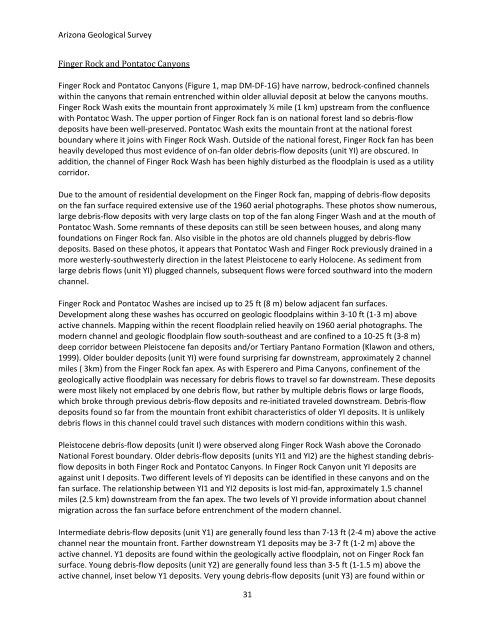Arizona Geological Survey OPEN-FILE REPORT OFR 08-06
Arizona Geological Survey OPEN-FILE REPORT OFR 08-06
Arizona Geological Survey OPEN-FILE REPORT OFR 08-06
You also want an ePaper? Increase the reach of your titles
YUMPU automatically turns print PDFs into web optimized ePapers that Google loves.
<strong>Arizona</strong> <strong>Geological</strong> <strong>Survey</strong><br />
Finger Rock and Pontatoc Canyons<br />
Finger Rock and Pontatoc Canyons (Figure 1, map DM‐DF‐1G) have narrow, bedrock‐confined channels<br />
within the canyons that remain entrenched within older alluvial deposit at below the canyons mouths.<br />
Finger Rock Wash exits the mountain front approximately ½ mile (1 km) upstream from the confluence<br />
with Pontatoc Wash. The upper portion of Finger Rock fan is on national forest land so debris‐flow<br />
deposits have been well‐preserved. Pontatoc Wash exits the mountain front at the national forest<br />
boundary where it joins with Finger Rock Wash. Outside of the national forest, Finger Rock fan has been<br />
heavily developed thus most evidence of on‐fan older debris‐flow deposits (unit YI) are obscured. In<br />
addition, the channel of Finger Rock Wash has been highly disturbed as the floodplain is used as a utility<br />
corridor.<br />
Due to the amount of residential development on the Finger Rock fan, mapping of debris‐flow deposits<br />
on the fan surface required extensive use of the 1960 aerial photographs. These photos show numerous,<br />
large debris‐flow deposits with very large clasts on top of the fan along Finger Wash and at the mouth of<br />
Pontatoc Wash. Some remnants of these deposits can still be seen between houses, and along many<br />
foundations on Finger Rock fan. Also visible in the photos are old channels plugged by debris‐flow<br />
deposits. Based on these photos, it appears that Pontatoc Wash and Finger Rock previously drained in a<br />
more westerly‐southwesterly direction in the latest Pleistocene to early Holocene. As sediment from<br />
large debris flows (unit YI) plugged channels, subsequent flows were forced southward into the modern<br />
channel.<br />
Finger Rock and Pontatoc Washes are incised up to 25 ft (8 m) below adjacent fan surfaces.<br />
Development along these washes has occurred on geologic floodplains within 3‐10 ft (1‐3 m) above<br />
active channels. Mapping within the recent floodplain relied heavily on 1960 aerial photographs. The<br />
modern channel and geologic floodplain flow south‐southeast and are confined to a 10‐25 ft (3‐8 m)<br />
deep corridor between Pleistocene fan deposits and/or Tertiary Pantano Formation (Klawon and others,<br />
1999). Older boulder deposits (unit YI) were found surprising far downstream, approximately 2 channel<br />
miles ( 3km) from the Finger Rock fan apex. As with Esperero and Pima Canyons, confinement of the<br />
geologically active floodplain was necessary for debris flows to travel so far downstream. These deposits<br />
were most likely not emplaced by one debris flow, but rather by multiple debris flows or large floods,<br />
which broke through previous debris‐flow deposits and re‐initiated traveled downstream. Debris‐flow<br />
deposits found so far from the mountain front exhibit characteristics of older YI deposits. It is unlikely<br />
debris flows in this channel could travel such distances with modern conditions within this wash.<br />
Pleistocene debris‐flow deposits (unit I) were observed along Finger Rock Wash above the Coronado<br />
National Forest boundary. Older debris‐flow deposits (units YI1 and YI2) are the highest standing debrisflow<br />
deposits in both Finger Rock and Pontatoc Canyons. In Finger Rock Canyon unit YI deposits are<br />
against unit I deposits. Two different levels of YI deposits can be identified in these canyons and on the<br />
fan surface. The relationship between YI1 and YI2 deposits is lost mid‐fan, approximately 1.5 channel<br />
miles (2.5 km) downstream from the fan apex. The two levels of YI provide information about channel<br />
migration across the fan surface before entrenchment of the modern channel.<br />
Intermediate debris‐flow deposits (unit Y1) are generally found less than 7‐13 ft (2‐4 m) above the active<br />
channel near the mountain front. Farther downstream Y1 deposits may be 3‐7 ft (1‐2 m) above the<br />
active channel. Y1 deposits are found within the geologically active floodplain, not on Finger Rock fan<br />
surface. Young debris‐flow deposits (unit Y2) are generally found less than 3‐5 ft (1‐1.5 m) above the<br />
active channel, inset below Y1 deposits. Very young debris‐flow deposits (unit Y3) are found within or<br />
31
















